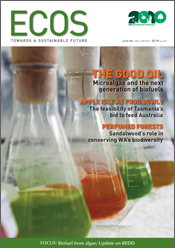
|
Published: 20 December 2010
Telltale radioactivity assists with erosion control
Radioactivity has long been associated with suffering and environmental disaster, but it also provides scientists with tools to assist with rehabilitation of degraded water bodies.

|
|
Flooding in the Lockyer Creek subcatchment, one of the sources of sediment in Moreton Bay. Credit: eWater CRC
|
Moreton Bay, 45 km from Brisbane, is a popular recreational destination that is also used by barge, ferry and water-taxi services, as well as commercial shipping traffic crossing its northern section.
During heavy rain, 24,000 km of degraded rivers pour sediment and pollutants into the Bay. Water sampling conducted late in 2009, a very wet year, showed that the Bay’s waters were in poor health.
Through tracing river sediments back to their source, Queensland scientists have now found that sediment load for the whole catchment could effectively be halved by rehabilitating stream banks and the major gullies. The science was developed by the eWater Cooperative Research Centre (eWater CRC) in conjunction with local landholders and was facilitated by the State Government’s South East Queensland Catchments initative (SEQ).1
‘It has played an integral role in guiding the landscape restoration works to reduce sedimentation in the Bremer focal area,’ says Amanda Bland, SEQ coordinator for the Bremer Catchment Healthy Country Project.
The scientists, led by Professor Jon Olley of Griffith University, focused their efforts on South East Queensland catchments that feed into Moreton Bay. They used techniques that can tell them whether the sediment originated as channel and gully erosion, or as shallow sheet or rill erosion further up hillslopes. This allows them to identify the primary sources of sediment, enabling rehabilitation to be targeted at those areas generating the most sediment.
Armed with sediment 'budgets' that pinpoint sub-catchments from which most of the sediment originates, catchment managers can understand which areas should be prioritised for environmental improvement. A sediment budget quantifies the sources, stores, and outputs of sediment throughout a catchment.
Sediment sampling has been concentrated on sub-catchments of the Logan River, Bremer River and Lockyer Creeks. The research team has identified the origin, transport pathways, and storage areas for sediment in each catchment enabling rehabilitation works to be targeted at the areas generating most of the sediment. A key finding is that, typically, 80 per cent of the sediment load derives from less than 10 per cent of a catchment's area.
Lessons from Knapp Creek
One of the first catchments studied was the 7,500 ha Knapp Creek catchment, part of the larger Logan catchment, where only 22 per cent of the original vegetation remains.
Prof. Olley estimates the 38 km of gullies in the Knapp Creek catchment have produced 820,000 tonnes of sediment since the catchment was first cleared. Currently, erosion is progressing at an estimated rate of 6000 tonnes of soil a year, most of which ends up in the river as sediment.
To work out where the sediment came from, the research team used a combination of remote sensing, field mapping, catchment scale modelling and sediment tracing. Critically they used the concentrations of the radioactive elements caesium-137, derived from nuclear weapons testing, and naturally derived fallout lead-210 to determine if the sediments in the rivers draining into Moreton Bay were derived from hillslope, channel bank or gully erosion. These radioactive elements coat the surface of the earth and are concentrated in the top 100 mm of soil. Because it is in the top layers, sediment derived from shallow (hillslope) erosion will register high concentrations of radioactivity, whereas sediment from deeper gully erosion or the erosion of subsurface channel bank material will have little.
By measuring the radioactivity of suspended material moving down the river and comparing this with the radioactivity of sediments, the scientists can work out the relative contributions of each erosion process.
Professor Olley says, ‘It is clear from the tracing results that channel bank and gully erosion dominate the supply of sediment to Moreton Bay.’
More information
eWater CRC, www.ewater.com.au
1 Funding was from the Queensland Government’s Healthy Country program, supported by the eWater CRC.



